Related Research Articles

Glassblowing is a glassforming technique that involves inflating molten glass into a bubble with the aid of a blowpipe. A person who blows glass is called a glassblower, glassmith, or gaffer. A lampworker manipulates glass with the use of a torch on a smaller scale, such as in producing precision laboratory glassware out of borosilicate glass.
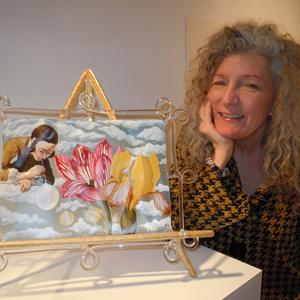
Ginny Ruffner is a pioneering American glass artist based in Seattle, Washington. She is known for her use of the lampworking technique and for her use of borosilicate glass in her painted glass sculptures.

Lenore Tawney was an American artist working in fiber art, collage, assemblage, and drawing. She is considered to be a groundbreaking artist for the elevation of craft processes to fine art status, two communities which were previously mutually exclusive. Tawney was born and raised in an Irish-American family in Lorain, Ohio near Cleveland and later moved to Chicago to start her career. In the 1940s and 50s, she studied art at several different institutions and perfected her craft as a weaver. In 1957, she moved to New York where she maintained a highly successful career into the 1960's. In the 1970s Tawney focused increasingly on her spirituality, but continued to make work until her death.
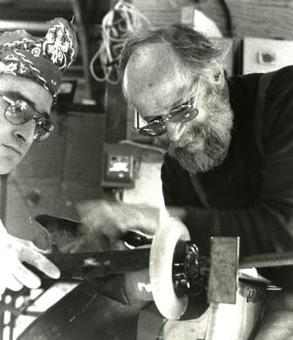
Harvey Littleton was an American glass artist and educator, one of the founders of the studio glass movement; he is often referred to as the "Father of the Studio Glass Movement". Born in Corning, New York, he grew up in the shadow of Corning Glass Works, where his father headed Research and Development during the 1930s. Expected by his father to enter the field of physics, Littleton instead chose a career in art, gaining recognition first as a ceramist and later as a glassblower and sculptor in glass. In the latter capacity he was very influential, organizing the first glassblowing seminar aimed at the studio artist in 1962, on the grounds of the Toledo Museum of Art. Imbued with the prevailing view at the time that glassblowing could only be done on the factory floor, separated from the designer at his desk, Littleton aimed to put it within the reach of the individual studio artist.

The A.H. Heisey Company was formed in Newark, Ohio, in 1895 by A.H. Heisey. The factory provided fine quality glass tableware and decorative glass figurines. Both pressed and blown glassware were made in a wide variety of patterns and colors. The company also made glass automobile headlights and Holophane Glassware lighting fixtures. The company was operated by Heisey and his sons until 1957, when the factory closed.
The Fostoria Glass Company was a manufacturer of pressed, blown and hand-molded glassware and tableware. It began operations in Fostoria, Ohio, on December 15, 1887, on land donated by the townspeople. The new company was formed by men from West Virginia who were experienced in the glassmaking business. They started their company in northwest Ohio to take advantage of newly discovered natural gas that was an ideal fuel for glassmaking. Numerous other businesses were also started in the area, and collectively they depleted the natural gas supply. Fuel shortages caused the company to move to Moundsville, West Virginia, in 1891.
Katherine Gray is a Canadian glass artist and professor of art at California State University, San Bernardino. Her work includes vases, candelabras, and goblets, and some of her pieces are designed to fit inside each other.

June Schwarcz was an American enamel artist who created tactile, expressive objects by applying technical mastery of her medium to vessel forms and plaques, which she considers non-functional sculpture.

Ann Robinson is a New Zealand studio glass artist who is internationally renowned for her glass casting work. Robinson is a recipient of the ONZM (2001) and a Lifetime Achievement Award by the American Glass Art Society (2006), and is a Laureate of the Arts Foundation of New Zealand (2006).
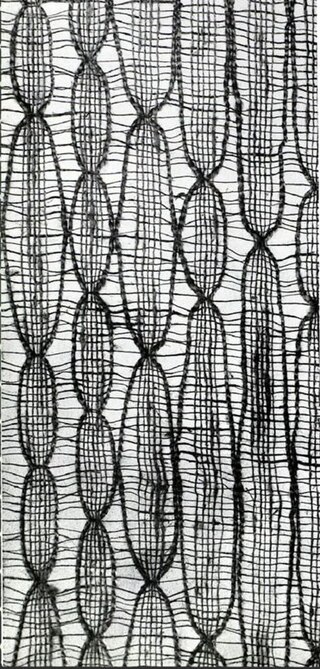
Kay Sekimachi is an American fiber artist and weaver, best known for her three-dimensional woven monofilament hangings as well as her intricate baskets and bowls.

Gertrud Amon Natzler was an Austrian-American ceramicist, who together with her husband Otto Natzler created some of the most praised ceramics art of the 20th century, helping to elevate ceramics to the status of a fine art.
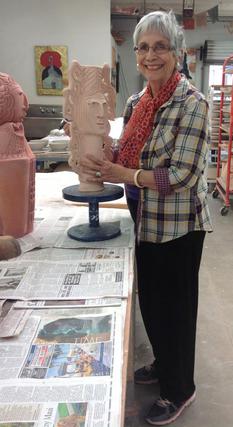
Dora De Larios was an American ceramist and sculptor working in Los Angeles. She was known for her work's clean lines and distinctive glazes, as well as for her line of tableware created under her family-run company Irving Place Studio. Also a muralist working with tile, De Larios was noted for her style, which reflects mythological and pan-cultural themes.

Ceramic art is art made from ceramic materials, including clay. It may take varied forms, including artistic pottery, including tableware, tiles, figurines and other sculpture. As one of the plastic arts, ceramic art is a visual art. While some ceramics are considered fine art, such as pottery or sculpture, most are considered to be decorative, industrial or applied art objects. Ceramic art can be created by one person or by a group, in a pottery or a ceramic factory with a group designing and manufacturing the artware.
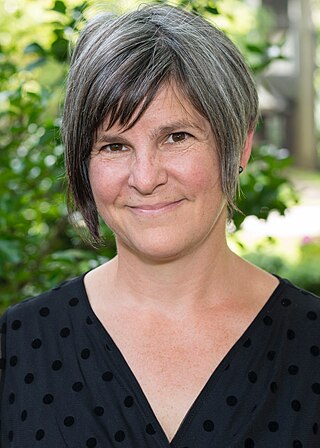
Beth Lipman is a contemporary artist working in glass. She is best known for her glass still-life compositions which reference the work of 16th- and 17th-century European painters.

Harrison Edward McIntosh was an American ceramic artist. He was an exponent of the Mid-century Modern style of ceramics, featuring simple symmetrical forms. His work has been exhibited in venues in the United States including the Smithsonian and internationally including at the Louvre in France.

Donald Lester Reitz was an American ceramic artist, recognized for inspiring a reemergence of salt glaze pottery in United States. He was a teacher of ceramic art at the University of Wisconsin–Madison from 1962 until 1988. During this period, he adapted the pottery firing technique developed in the Middle Ages, which involved pouring salt into the pottery kiln during the firing stage. The method was taught in European ceramic art schools, but largely unknown in United States studio pottery.
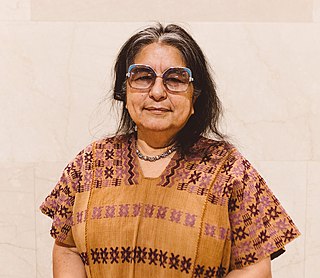
Consuelo Jiménez Underwood is an American fiber artist, known for her pieces that focus on immigration issues. She is an indigenous Chicana currently based in Cupertino, California. As an artist she works with textiles in attempt to unify her American roots with her Mexican Indigenous ones, along with trying to convey the same for other multicultural people.

Mary Ann Zynsky, better known as Toots Zynsky, is an American glass artist.

Frances Higgins was an American glass artist. She is best known for establishing the Higgins Glass studio with her husband Michael Higgins.
Lillie May Nicholson (1884–1964) was an American painter and educator from Northern California. Her artwork is in the collections of the Monterey Museum of Art, the Smithsonian American Art Museum, and the White House Collection. She is also known as Lillie De Wolf.
References
- 1 2 3 "Ann Morhauser". Smithsonian American Art Museum . Retrieved March 30, 2023.
- ↑ Morhauser, Ann (March 16, 2013). "Ann Morhauser: Where do you think artists come from?". Santa Cruz Sentinel .
- ↑ Fisher, Larry (February 25, 1990). "Style Makers" . The New York Times . p. 42.
- 1 2 Colón, Brisa (23 October 2022). "Santa Cruz County recognizes a Watsonville glassblowing artist as its Artist of the Year". KSBW .
- ↑ Smith, Eileen. "A touch of glass", Courier-Post , May 3, 1997. Accessed March 31, 2023, via Newspapers.com. "She was reared in Collingswood, the youngest of four children and the only girl. Her father managed the Ship Builder's Credit Union in Camden and her Italian mother managed the household. Her budding interest in art was nurtured at Transfiguration School in Collingswood, and later at Paul VI High School in Haddon Twp."
- 1 2 Green, Alisha (September 5, 2019). "Glass-Powered: How Annieglass Stays On The Cutting Edge". Silicon Valley Business Journal .
- 1 2 3 Miazaki, Vinicius (10 December 2017). "The Glass Builder - A Story of Craftsmanship and artisanal Success". The Craftsmanship Initiative.
- ↑ The founder of Annieglass took feedback about her company seriously. MSNBC (television news video). May 10, 2018.
- ↑ Konstantinovsky, Michelle. "Designer Crush: Annie Morhauser". California Home+Design .
- ↑ Chanprasith, Manivanh (March 28, 2010). "California glass artist hosting recipe contest downtown". The Vicksburg Post. Vicksburg, Mississippi. p. 21 – via Issuu.
- ↑ Knight, Beverly (April 16, 2002). "Liven up your dining room table with Annie's glass Glass artist Ann Morhauser". Spartanburg Herald-Journal .
- ↑ "New Glass Review 14" (PDF). Corning Museum of Glass . 1993. p. 49. Retrieved March 30, 2023.
- ↑ "Santa Cruz County: Artist of the Year, Annie Morhauser of Annieglass (film)". Santa Cruz County official website. October 22, 2022.